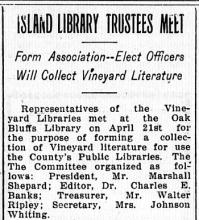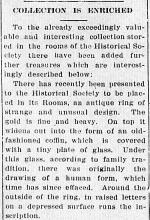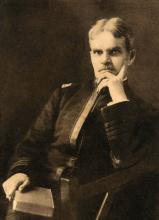“Old Ironsides,” the frigate Constitution, and the most famous of an ship to fly the American flag, was built by a Vineyard man. Furthermore, the head foreman under the builder was also from this Island. These facts are established by historical and genealogical research, recently carried on by the Dukes County Historical Society and by other interested persons, notably F. G. Hillman of New Bedford. Much connecting evidence has been supplied by William J. Rotch and Mrs. Johnson Whiting of West Tisbury, and it is through their efforts and willingness to share the fruits of their labors with the public that the facts are thus presented.
The builder of the Constitution was Colonel George Claghorn, who was born in Chilmark, near Roaring Brook, and his foreman, if that be the correct title, was Prince Athearn of North Tisbury.
Master Builder of Renown
Colonel Claghorn was the son of Shubael Claghorn, and was a ship carpenter and master builder of renown even before the Constitution was thought of. He is said to have conducted a business at Assonet at one time, but whether or not this is true it is historically recorded that he was in business in New Bedford previous to 1785, for in that year he launched the whaleship Rebecca from his own yard, the first American whaler to sail around Cape Horn.
When plans for the building of the famous frigate were made the best shipbuilder in the country was sought, and George Claghorn of Martha’s Vineyard was chosen. He was Capt. George Claghorn at that time, for he had served in that capacity with the land forces during the Revolutionary War. That his work was good there is ample evidence, but the details of the building are lost to us except for such few facts as are to be found in an old copy of the Cincinnati Commercial, which carried the report of an interview with Prince Athearn after he had reached the age of 90.
The explanation of this peculiar fact is partially explained in the article and partly by Mr. Rotch. Prince Athearn was born in North Tisbury, in what is known by older people as the Zadoc Athearn house, now owned by Godfrey Priester. His history as related by himself is far more complete than that of Claghorn, although the latter was not lost sight of after the ship was built.
Athearn “Second in Command”
Athearn learned his trade of shipbuilder in Nova Scotia, going there from the Vineyard to serve his apprenticeship at the age of 17. He worked later in the yards at Portland and then in New Bedford, where he was living at the time that Claghorn sought builders. Chosen to take the position of foreman under the builder, or “second in command,” as he styled it, his first duty was to take a vessel to the Kennebec River, Maine, to get the timber for the frigate’s keel and side timbers.
On his return he laid the keel in Hart’s yard at Boston, near the Charleston Bridge, and worked on the ship until she was successfully launched.
During the war of 1812, Mr. Athearn sailed a fast sloop called the Dart, between New Bedford and New York, on blockade-running expeditions, and had many narrow escapes from capture or death. He was one of the western pioneers, going west with his wife in 1814, where he settled at Rising Sun, Indiana, living there for the remainder of his life. He built the first two steamers ever launched at Cincinnati and others which ran on the great inland waterways. Late in life he met with financial reverses and but for his children would have come to want, according to the Commercial. This, singularly enough, is similar to the ending of Claghorn’s career.
Military Interests
Claghorn returned to New Bedford after building the Constitution and along with his business seemed to gave taken an interest in the military affairs, due probably to the fact that he was a veteran. He was attached to the 2nd Massachusetts regiment, attaining the rank of major and later when Colonel Massaseh Kempton resigned and Lt. Col. Joseph Durfee removed to Rhode Island, Claghorn was promoted to the rank of colonel, and given command of the regiment, which he retained for about ten years.
He met with misfortune which reduced him to penury and his pride would not allow him to associate with his former friends. He therefore removed to a secluded spot in Rehoboth, where he lived and died a recluse.
These facts should hold an absorbing interest for Vineyarders, many of whom are descendents of these famous men, especially at this time when a great effort is being made to preserve the celebrated ship.
Exploits of “Old Ironsides”
The Constitution was of 1576 tons burden and designed to carry 44 guns, but mounted 52. Her first important mission was to Tripoli in company with the frigate Philadelphia, which ran aground and was captured. On the night following Stephen Decatur, a young officer of the Constitution, ran into the harbor of Tripoli under the guns of the fort with a small boat manned by a few seamen, and taking the prize crew by surprise drove them over the side and set fire to the Philadelphia, destroying her. The Constitution then bombarded the city, forcing the release of the captured crew.
Under the command of Isaac Hull, “Old Ironsides” made her escape from a British fleet which partially surrounded her in a calm on on July 17, 1812, off the coast of Spain. Hull kedged his ship, by carrying out his lightest anchor at the end of all the cable he had, capable of standing the strain, and pulling her ahead by means of his windlass. For two days and nights this was kept up and as the second night approached a squall struck and he was able to escape. The chase lasted 64 hours and not once did the enemy approach within gunshot.
On August 19, under the same captain, the Constitution took the English frigate Guerriere of 38 guns after an action of 30 minutes. On Dec. 29 of the sane year under Capt. William Bainbridge the English frigate Java of 49 guns was taken near San Salvador. On Feb. 14, 1814. under Capt. Charles Stewart she took the English privateer Pictou of 16 guns, and on Feb. 20, 1815, off Lisbon, took the frigate Cyane of 36 guns and the Levant of 18 in 45 minutes. Both were English ships.
The war of 1812 ended shortly after this and the old frigate never engaged in action after, although she was used as a school ship for many years.

From the March 25, 1927 edition of the Vineyard Gazette:
To Honor Builders of Constitution
Following the announcement last week that Vineyard historians - William J. Rotch and Mrs. Johnson Whiting, the Dukes County Historical Society, and F. G. Hillman of New Bedford - had established that the frigate Constitution was built by Vineyard men, the Vineyard Gazette now proposes a memorial tablet to be placed on board “Old Ironsides” in memory of Colonel George Claghorn and Prince Athearn. These men, the one of Chilmark, and the other of North Tisbury, were the masters of the shipbuilding art responsible for the most famous of American Frigates.
As the vessel itself has been preserved through the years, its seems fitting that the memory of the builder and his foreman should be enshrined with it. A suitable bronze tablet, inscribed with the names and essential facts, is a natural form for the memorial to take. Aboard the Constitution, it would give to all visitors the first chapter of the vessel’s story and link the frigate with the tradition of Martha’s Vineyard.
In line with this idea, the Gazette pledges an initial subscription of $5 toward the necessary amount, which is estimated at $200.
Contributions Invited
The contribution of a greater or less amount by interested Vineyarders would insure the success of the project, and at the same time give the memorial a representative character which it would not have were the entire amount contributed by a single individual.
The Gazette invites expressions of opinion and pledges of other contributions. Letters from readers and acknowledgement of pledges will be made in next week’s issue.
If the amount required is available, the Gazette proposes that the entire project be placed in the hands of the Island historians who made the successful researches. The funds contributed will be placed at their disposal for the selection of a suitable tablet and the wording of an appropriate inscription. In view of the historical purpose served by the Constitution, and the patriotic auspices under which it has been so long preserved, the acceptability of the proposed tablet for unveiling on the vessel is assured in advance.











Comments